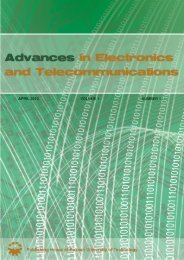november 2010 volume 1 number 2 - Advances in Electronics and ...
november 2010 volume 1 number 2 - Advances in Electronics and ...
november 2010 volume 1 number 2 - Advances in Electronics and ...
Create successful ePaper yourself
Turn your PDF publications into a flip-book with our unique Google optimized e-Paper software.
ADVANCES IN ELECTRONICS AND TELECOMMUNICATIONS, VOL. 1, NO. 2, NOVEMBER <strong>2010</strong> 67<br />
Precise Measurements of Highly Attenuated Optical<br />
Eye Diagrams<br />
Przemysław Krehlik, Łukasz ´Sliwczyński, <strong>and</strong> Grzegorz Sikorski<br />
Abstract—The idea <strong>and</strong> practical realization of a measurement<br />
system dedicated for highly attenuated eye diagrams diagnostics<br />
is presented <strong>in</strong> the paper. It is specially oriented on high-speed<br />
modulated optical data transmission signals which amplification<br />
is difficult <strong>and</strong>/or undesired. The presented measurements displayed<br />
the usefulness of proposed solution.<br />
Index Terms—eye diagram, optical measurements, noise reduction<br />
I. INTRODUCTION<br />
A NALYSISoftheeyediagram(calledalsotheeyepattern)<br />
is a simple but powerful method of digital transmission<br />
channel diagnostics. The eye diagram arises from overlapp<strong>in</strong>g<br />
many differentdata patterns time-shiftedby an <strong>in</strong>teger <strong>number</strong><br />
of unit <strong>in</strong>tervals (i.e. serial clock cycles) – see Fig. 1a.<br />
Degradation of the digital signal, caused by the transmission<br />
channel, may be thus recognized <strong>and</strong> measured. Some well<br />
known cases of signal distortions are illustrated on Fig. 1b.<br />
The simplest way to obta<strong>in</strong> the eye diagram is to register<br />
the data signal with an oscilloscope hav<strong>in</strong>g long persistence,<br />
dur<strong>in</strong>gthesynchronizationofthetimebasefromthedataclock<br />
signal (alternatively divided by any <strong>in</strong>teger factor).<br />
In case of fast optical signals, the best choice is to use<br />
the sampl<strong>in</strong>g oscilloscope with the optical-to-electrical (O/E)<br />
converter <strong>in</strong>tegrated with the sampl<strong>in</strong>g unit. This solution<br />
offers the outst<strong>and</strong><strong>in</strong>g equivalent b<strong>and</strong>width up to 70 GHz,<br />
with flat frequency response <strong>and</strong> low group delay dispersion<br />
[1]. However, it suffers from relatively high noise, <strong>in</strong> range<br />
of 10 ... 20 µWRMS of equivalent optical power. The noise<br />
disturbs or even completely blurs the observed eye diagram<br />
when the measured signal is strongly attenuated by long fibers<br />
or other optical devices. In some cases the problem may be<br />
overcome by us<strong>in</strong>g an optical amplifier, or external O/E converter<br />
followed by electronic amplifier. Unfortunately,<strong>in</strong> some<br />
situationsthose solutionscouldnot be usedor are suspectedof<br />
<strong>in</strong>troduc<strong>in</strong>g some artefacts affect<strong>in</strong>g the measurement results.<br />
Therefore, some method of noise reduction<strong>in</strong> the eye diagram<br />
measurements is desired.<br />
II. THE IDEA OF EYE NOISE REDUCTION<br />
A well known method of noise reduction, used <strong>in</strong> the measurements<br />
of periodic signals on digitis<strong>in</strong>g oscilloscopes, is to<br />
P. Krehlik is with the Institute of <strong>Electronics</strong>, AGH University of Science<br />
<strong>and</strong> Technology, Mickiewicza 30, 30-059 Kraków, Pol<strong>and</strong>; e-mail:<br />
krehlik@agh.edu.pl.<br />
Ł. ´Sliwczyński is with the Institute of <strong>Electronics</strong>, AGH University of<br />
Science <strong>and</strong> Technology, Mickiewicza 30, 30-059 Kraków, Pol<strong>and</strong>; e-mail:<br />
sliwczyn@agh.edu.pl.<br />
G. Sikorski graduated from AGH University of Science <strong>and</strong> Technology <strong>in</strong><br />
2007.<br />
Fig. 1. The idea of the eye diagram construction (a), <strong>and</strong> common eye<br />
distortions (b).<br />
average many registrations of the same trace (so called boxcar<br />
averag<strong>in</strong>g). When the noise is zero mean <strong>and</strong> uncorrelated<br />
<strong>in</strong> subsequent measurements, the root-mean-square (RMS) of<br />
the noise is reduced accord<strong>in</strong>gly to the square root of the<br />
<strong>number</strong> of averaged registrations. In the ord<strong>in</strong>ary eye diagram<br />
measurement, however, the overlapp<strong>in</strong>g of different patterns<br />
on the scope screen prohibits direct averag<strong>in</strong>g.<br />
The presented idea changes the manner of collect<strong>in</strong>g signal<br />
samples to allow averag<strong>in</strong>g-basednoise reduction. The pattern<br />
generator, connected to the <strong>in</strong>put of transmission l<strong>in</strong>k under<br />
test, outputs a set of different data sequences. Each sequence<br />
is repeated a <strong>number</strong> of times to allow the averag<strong>in</strong>g of<br />
particular patterns measured at the tested l<strong>in</strong>k output. F<strong>in</strong>ally,<br />
all stored averaged patterns are overlapped <strong>and</strong> shown on<br />
“virtual” oscilloscope display – see Fig. 2.<br />
It should be realized that the described method of the eye<br />
diagram construction changes <strong>in</strong> some way the <strong>in</strong>formation<br />
gathered <strong>in</strong> the eye diagram. By reduc<strong>in</strong>g the measurement<br />
noise it clarified all pattern dependent signal distortions (<strong>in</strong>tersymbol<br />
<strong>in</strong>terferences (ISI), nonl<strong>in</strong>ear distortions, pattern dependent<br />
jitter <strong>and</strong> so on). At the other h<strong>and</strong>, however, the<br />
averag<strong>in</strong>g reduces not only measurement noise but also any<br />
possibler<strong>and</strong>omevents<strong>in</strong>thereceivedsignal,suchastransmitter<br />
relative <strong>in</strong>tensity noise (RIN), optical amplifier amplified<br />
spontaneous emission (ASE), adjacent signals crosstalks <strong>in</strong><br />
multichannel systems etc.<br />
III. MEASUREMENT SYSTEM IMPLEMENTATION<br />
Based on the idea presented above, a measurement system<br />
dedicated for measur<strong>in</strong>g highly attenuated optical eye<br />
diagrams was built. The system (see Fig. 3) is based on







